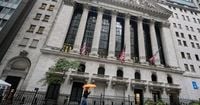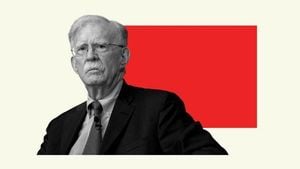Wall Street wrapped up the week of October 17, 2025, on a high note, with the S&P 500, Nasdaq, and Dow Jones Industrial Average each climbing 0.5% and posting their strongest weekly gains since early August. The upbeat finish came as financials and consumer staples led a broad market advance, helping investors shake off recent anxieties about the health of the banking sector and the unpredictable trajectory of U.S.-China trade relations, according to reporting from the Associated Press and other financial news outlets.
The week had been a roller-coaster for investors, with sharp swings driven by mounting fears over souring loans at regional banks and renewed uncertainty about tariffs on Chinese imports. But by Friday, those worries had eased—at least for the moment. Regional banks, which had been at the center of Thursday’s market drama, staged a notable comeback. Zions Bancorporation, for instance, rebounded 5% after revealing it was charging off $50 million in loans due to what it called “apparent misrepresentations and contractual defaults” by borrowers. The bounce followed a punishing 13.1% drop the previous day. Similarly, Western Alliance Bancorp, which is embroiled in a lawsuit alleging borrower fraud, recovered 2% after a 10.8% tumble.
The broader indexes tracking regional banks and financial stocks also bounced back, easing fears about a potential credit crunch. This resurgence was buoyed by robust quarterly earnings from major players: JPMorgan, Truist Financial, and Fifth Third Bancorp all reported profits that surpassed analysts’ expectations. As a result, the S&P 500 ended the week at its richest valuation in five years, a signal of fresh faith in the group’s durability and the market’s appetite for risk.
But the optimism wasn’t limited to the U.S. financial sector. Jefferies Financial Group, which had lost roughly 30% of its value since mid-September, rallied 5.9% on Friday. The firm had been under scrutiny following the Chapter 11 bankruptcy filing of First Brands Group, a supplier of aftermarket auto parts, which raised broader questions about the quality of loans across the industry. As scrutiny increased, the market was left to wonder whether these were merely isolated incidents or the first signs of more systemic trouble. In a candid moment on an earnings call, JPMorgan CEO Jamie Dimon cautioned, “When you see one cockroach, there are probably more. Everyone should be forewarned on this one.”
Yet, some experts urged calm. Brian Jacobsen, chief economist at Annex Wealth Management, noted, “Banks make loan loss provisions and typically have plenty of capital to keep the cockroaches from causing structural damage. Based on earnings and data so far, it looks like this isn’t an infestation and that the potential canary in the coal mine is probably passed out and not dead.” The message: while vigilance is warranted, there’s little evidence yet of a full-blown crisis.
Outside the banking sector, the market’s mood was also shaped by shifting signals from Washington. U.S.-China trade tensions have been simmering, with talk of renewed tariffs and stricter export controls keeping investors on edge. However, President Donald Trump’s comments on Friday offered some relief. Speaking to Fox News, he said that “very high tariffs on China are not sustainable” and hinted at a possible meeting with Chinese leader Xi Jinping at an upcoming conference in South Korea. The president’s remarks helped calm some of the market’s nerves, though the underlying tensions remain unresolved.
The CBOE volatility index, a popular gauge of market anxiety, eased as the week drew to a close. Still, analysts warned that the unpredictable nature of U.S. trade policy—especially regarding China—could mean more choppy waters ahead. The ongoing chess match between U.S. regulators and their Chinese counterparts is particularly fraught in sectors like technology and healthcare, where new export restrictions and regulatory hurdles can move markets in an instant. For example, Eli Lilly’s shares recently dropped on regulatory news, underscoring how quickly sentiment can shift.
Meanwhile, the bond market saw some stabilization. After a surge in demand for safe-haven assets on Thursday, Treasury yields steadied on Friday, with the 10-year yield inching up to 4.00% from 3.99%. Gold, which had soared to record highs amid expectations of Federal Reserve interest rate cuts and mounting concerns over global government debt, pulled back 2.1% to $4,213.30 per ounce. Even so, gold prices remain up about 60% for the year—a striking reflection of persistent investor unease.
Global markets, however, didn’t share in Wall Street’s Friday optimism. European and Asian indexes tumbled in the wake of Thursday’s U.S. market weakness. Germany’s DAX slid 1.8%, and Hong Kong’s Hang Seng sank 2.5%, as the aftershocks of Wall Street’s earlier jitters rippled across continents. The volatility abroad highlighted how closely linked global markets have become, with policy shifts and economic data in one region quickly reverberating elsewhere.
Despite the positive finish for U.S. stocks, market watchers cautioned that the path ahead remains uncertain. The S&P 500’s lofty valuation—its highest in five years—reflects both strong earnings and a willingness among investors to look past near-term risks. But with trade policy swinging unpredictably and the specter of bad loans still looming over parts of the banking sector, some analysts warned that investors could face more turbulence in the weeks to come.
For now, though, the mood on Wall Street was one of cautious relief. The week’s gains, driven by a rebound in financials and reassuring earnings reports, offered a reprieve from recent worries. But as the chess game of global economic policy continues, and as markets digest the latest twists in trade relations and banking health, investors will be watching closely for the next move.
It’s a reminder that in modern finance, fortunes can change in a flash—and that even in a week marked by gains, uncertainty is never far from the surface.




